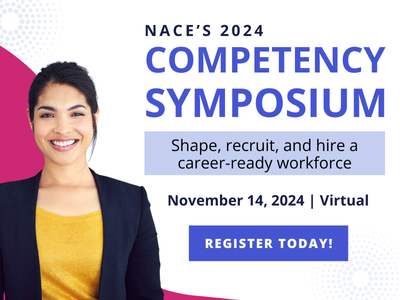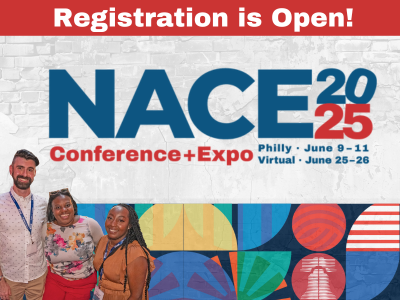Enhancing College Student Participation Through Support, Structure, and Choice
NACE Journal / Winter 2023
In many of our college classrooms, students who have traveled around the world and interned with name-brand companies sit side by side with equally smart students who have spent every summer working two minimum wage jobs and have never left the state. While both students will receive the same piece of paper upon graduation, those of us who are positioned in career centers and see scads of resumes know full well that a student who has only completed the basic degree requirements isn’t likely to see transformative outcomes. However, we have also seen what can happen when students, particularly those from historically underserved backgrounds, find that early first experience that unlocks the next and the next…setting them on a trajectory and launching them into careers never imagined. Experiential learning opportunities, such as internships, mentored research, and study abroad, are high-impact practices (HIPs), and forward-thinking institutions can be intentionally structuring them throughout the student’s journey to support even greater success.
In 2018, Nazareth College implemented an early experiential learning initiative titled “Students Pursuing Academic and Real-world Knowledge,” or the SPARK grant. The SPARK grant is open to first- and second-year students (and transfers in their first 12 months) and designed to encourage early experiential education. Students receive structured guidance and support through career coaches in the Center for Life’s Work as they plan and “spark” learning, growth, and connections. The grant provides $1,500 scholarships and tuition waivers for credit-bearing experiences, to help cover costs for international experiences, unpaid summer internships, or mentored research. The SPARK grant earned honors for innovation as the winner of the NACE/Chevron Award in 2019. Three years, one pandemic, and 907 student participants later, the grant is still going strong. More importantly, it is providing evidence that institutions really do have an ability, and therefore, the responsibility, to move the needle on participation in HIPs, specifically when it comes to championing early experiential learning.
Literature Review
High-impact practices are a set of established, educationally effective, highly engaging learning activities linked with multiple indicators of student success in college.1 When done well, they involve opportunities to reflect, receive feedback, connect with faculty or supervisors, and discover relevance and competence through significant time invested in real-world applications of learning.2 Some practices are more campus-based, e.g., senior year capstone experiences and first-year learning communities, while others are more community-based, such as study aboard, internship, and service-learning programs.
The positive correlation between student participation in HIPs and a host of widely sought institutional metrics—such as improved retention, engagement, graduation rates, career preparation, and student satisfaction—have been broadly researched and reviewed.3 Further, when students complete multiple HIPs during their college journey, compounded learning occurs and gains are magnified.4 A 2022 study found that for each additional HIP completed, students boost their job or continuing education placement odds as well as their starting salary.5
Given the overwhelmingly positive data about HIPs, one would expect that colleges would be integrating them into every nook and cranny of the college experience as early as possible. Indeed, on-campus HIPs, such as first-year seminars and writing-intensive courses, are routinely and intentionally included in first-year curricula.6 Additionally, providing experiences early in college creates the structure and space required to build in additional HIPs. When purposeful institutional scaffolding occurs, experiences can be embedded and an early HIP can actually boost preparation, competence, and confidence for a later HIP, such as a capstone or culminating fieldwork.7
However, despite widespread awareness of the benefits of HIPs, universities have yet to systemically tackle the participation barriers students encounter in HIPs that happen off campus, in the community, and/or during the summer months. The 2021 National Survey of Student Engagement (NSSE) Career and Workforce Preparation Module found that only 49% of continuing generation seniors reported participating in an internship, with first-generation seniors reporting an even lower internship participation rate of 35%.8 Hurdles such as a lack of transportation, time, or financial resources—including forgoing an unpaid summer internship due to the necessity of securing paid employment or covering the cost of a plane ticket to study abroad—can exclude students who have already been historically underserved.9
Fortunately, an encouraging trend emerging in the literature acknowledges institutions share responsibility for equity in access to experiential learning. For example, one recent article champions an institution-wide coordination effort in data collection of HIPs to best inform resource allocation and support structures while another investigates the impact of social and cultural capital on participation in HIPs that occur in the summer months.10 Similarly, growing research on HIP participation using an identity-conscious lens demonstrates a will and a desire to support and strengthen access for all students.11
Additionally, a burgeoning number of scholars are now reminding institutions that positive HIP outcomes rely on quality, student major/career field, and volition.12 True equity then becomes a balancing act where institutions provide enough support and structure to ensure access while also remaining true to core experiential learning principles that avoid a “cookie-cutter” approach, but instead center the choice and motivation of the learner.13
SPARK Grant Details
While many institutions now provide funding to pursue unpaid experiential learning, the SPARK grant differs in two ways.
First, the grant is specifically for early experiential learning and is open to all students with a GPA of 2.5 or greater; an application is required, but the grant is not selective beyond GPA, and there is no limit on recipients. Students are only eligible in their first two years (or in their first 12 months as transfer students). Given that many institutions require some sort of fieldwork at the upper level, SPARK was specifically designed to make possible an additional experience early in the college journey. In order to provide time and space for the synergistic benefits of multiple HIPs to occur, Nazareth sought to normalize, encourage, and build early experiential learning into its structure and systems.
Second, students receive intentional and targeted support through the Center to determine how to best use their grant based on their personal and professional interests and goals. The Center serves as a hub for several experiential learning activities and uses a liaison-based model, i.e., career coaches cover groupings of related majors. Therefore, career coaches are well-versed in connecting their students with traditional career center activities such as internships, but also with research, community-engaged learning, and study abroad opportunities. Students early in their college journey often need examples of what is possible or ask to see “the list” of what other students have done, while others come to the Center with very specific goals, like the percussion major who wanted to spend his summer interning with a nationally touring drum and bugle corps. Coaches are able to replicate and seek out new SPARK opportunities through employers and alumni based on past successes. The coaching support guides students through options that are flexible, affordable, interest-driven, and curated.
Ensuring Experiences Are High Impact
Nazareth has an experiential learning (EL) requirement as part of its core curriculum. While there are eight approved EL pathways in the curriculum, the SPARK grant intentionally integrated three of the pathways—internships, study abroad, and mentored research—based on the literature citing equity gaps and participation barriers in off-campus and summer experiences.14
SPARK experiences are vetted by experiential learning pathways leaders, ensuring the opportunities meet Nazareth’s standards. All internships and research are credit-bearing so students are simultaneously enrolled in a one- or three-credit course designed to enhance and connect their experience to their academics. A secondary benefit of the grant is that the tuition for these credits is covered by the grant, ensuring that students do not incur additional tuition expenses as a result of their participation.
Nazareth’s Center for International Education offers programs in 33 countries—and maintains a list of partner sites that is regularly reviewed and updated—and includes both semester-long and short-term experiences so that students with a variety of majors and life circumstances can find a program and a time frame that fits their situation. As opposed to a “one-size-fits-all” approach, career coaches are able to sort through these choices with students and serve as the initial and primary contact for all SPARK applications.
Building Student Awareness
Students are introduced to the SPARK program in a number of ways. During orientation, new students attend a session where they meet their career coach and hear about ways upper-level students and alumni have used the grant. In the first week of classes, career coaches again interact with new students through a visit to their first-year seminar course. Coaches communicate and partner with academic departments and faculty advisers to share SPARK usage data—including a list of their still-eligible advisees—and encourage additional conversations during the advising and registration period. In the spring semester, coaches visit a required introductory writing course to again prompt conversation. Throughout the year, coaches touch base with the students in their majors through one-on-one appointments, classroom visits, programs, and communications.
Assessing the Impact of SPARK
SPARK and HIP participation rates
Participation data in study abroad programs as well as summer internships were analyzed in the time frame before and during the advent of the SPARK program. (Note: While summer research existed at Nazareth before SPARK, the format of the SPARK research
option was new; therefore, there were no pre-SPARK research data to compare.)
Since its inception in January 2018, 907 students have participated in SPARK’s three pathways. (See Table 1.)
As Table 2 shows, participation in total credit-bearing summer internships increased 125% in 2018, the year SPARK was introduced. Similarly, study abroad participation jumped as well, with short-term programs increasing 157% in the first year.
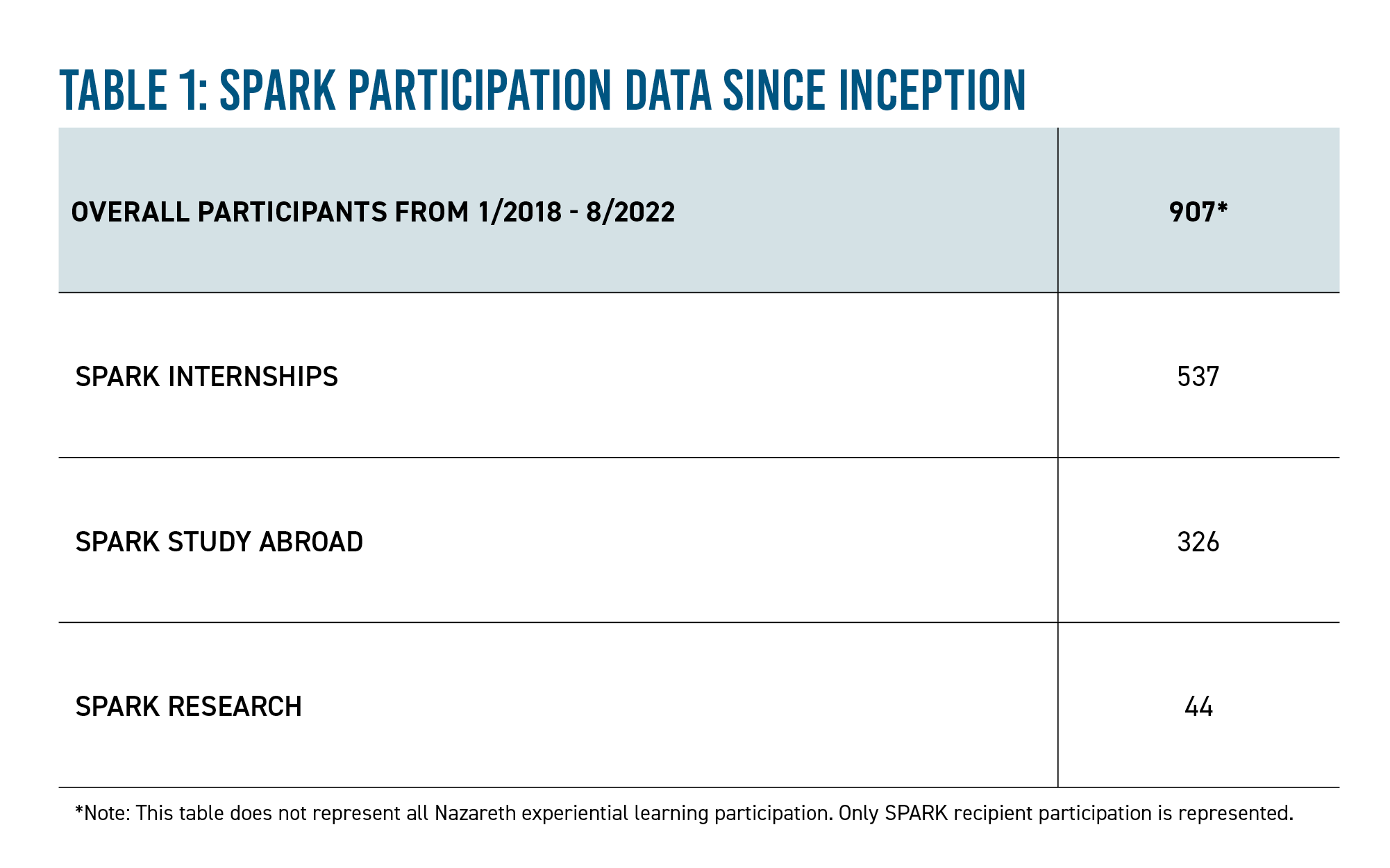
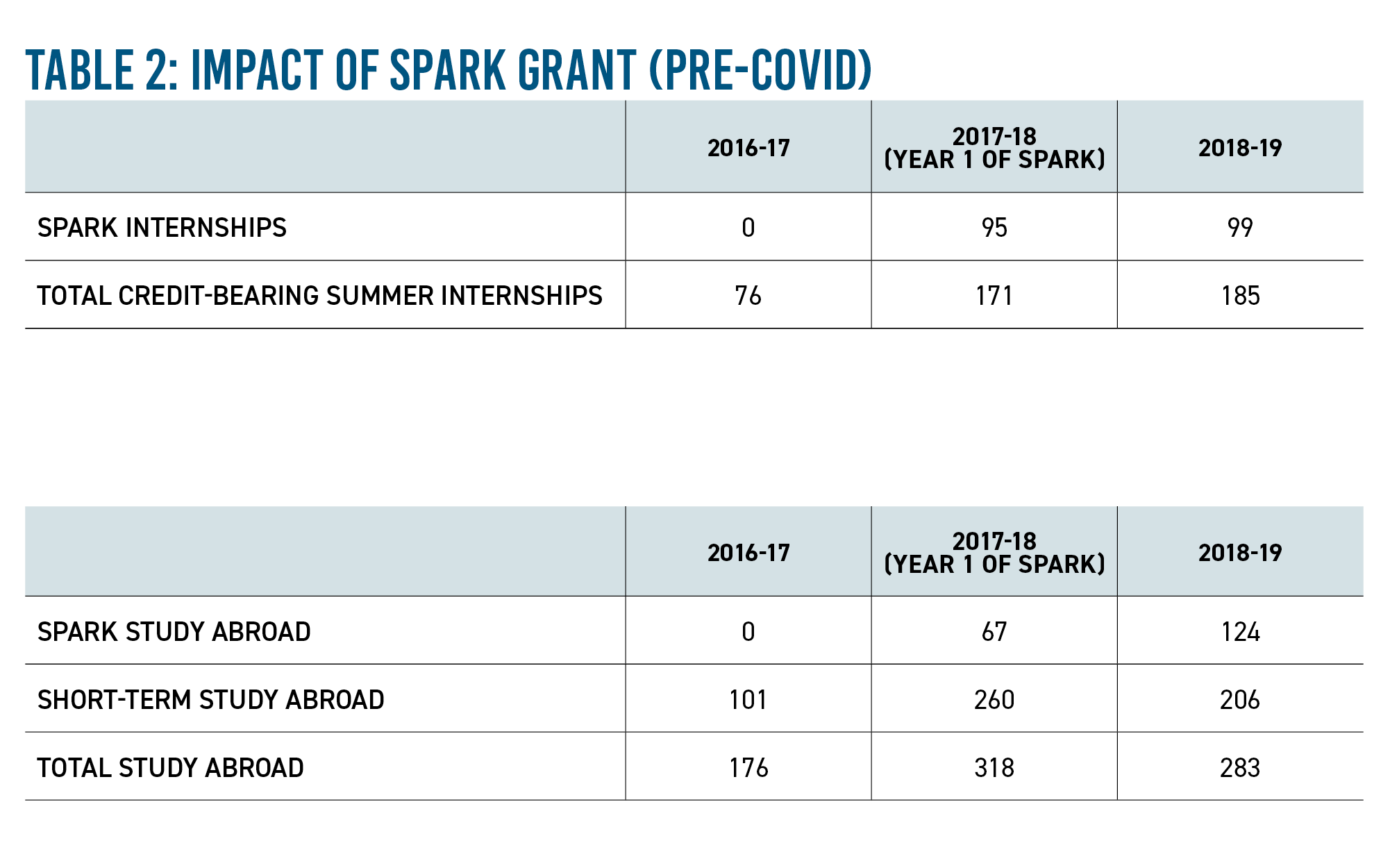
Impact on student success
In order to generate statistics related to overall student success metrics, such as GPA, retention rates, and time to graduation, first-year class cohort data were followed and examined. Transfer students do participate in SPARK and are definitely worthy
of research, but for the purpose of this research, data from 723 participants who started as first-year students were analyzed.
As shared in Table 3, the GPAs, retention rates, and graduation rates of SPARK participants are consistently higher
than the non-SPARK participants, with the impact being particularly noticeable for underrepresented minority students. These students experienced a 42% bump in four-year graduation rates, and average GPAs increased from 2.68 to 3.32. Underrepresented
minority students comprised 15% of Nazareth’s total population during the cohorts measured, but made up 20% of SPARK participants during that same time.
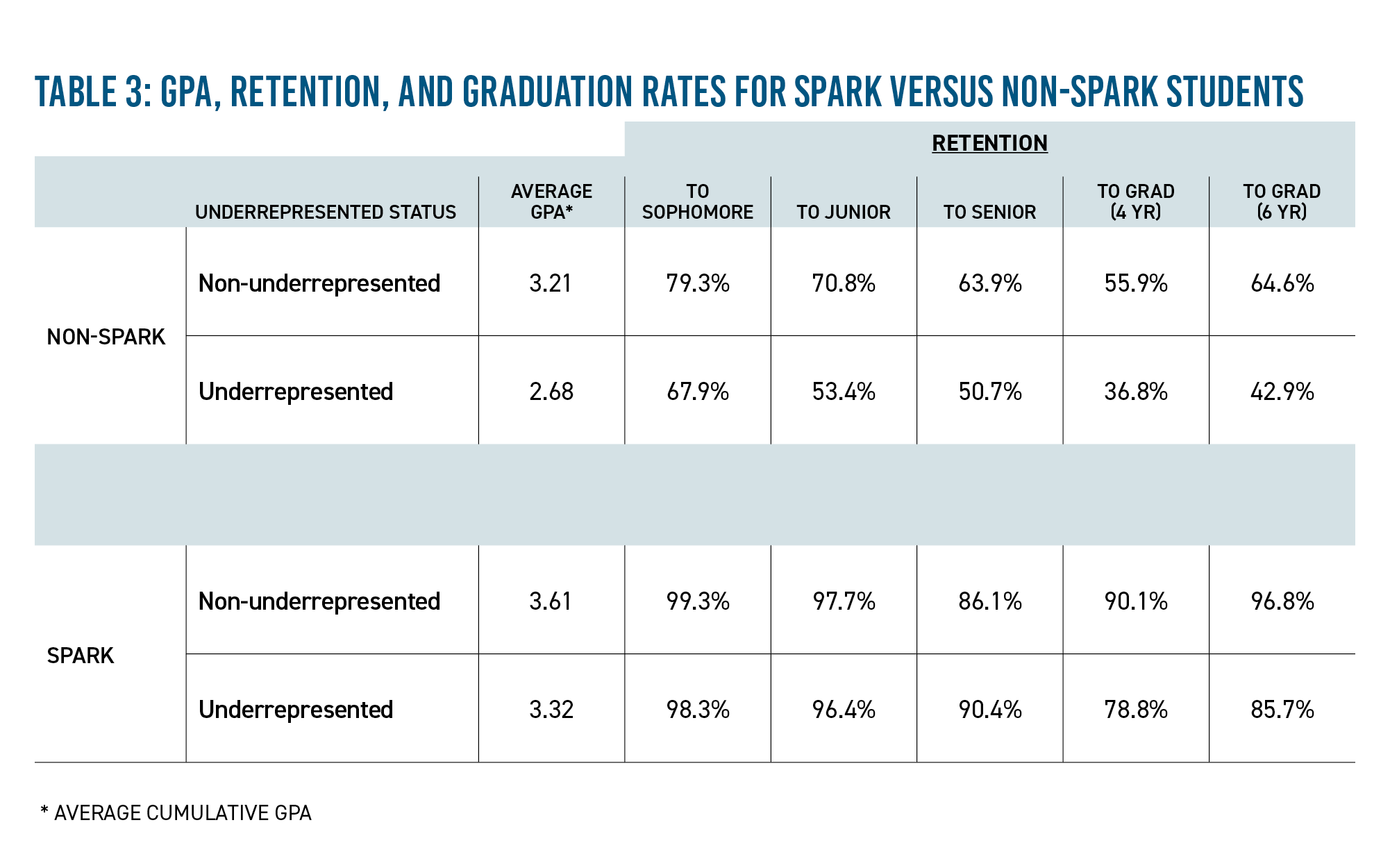
Increased overall engagement
Beyond increased participation and student success metrics—increased GPAs and retention and graduation rates—SPARK participants themselves continue to engage in a variety of forms of experiential learning at a higher rate than non-SPARK participants. (See Figure 1.)
In some cases, SPARK participants complete a second experience within their original pathway, i.e., they complete two internships, but the increased engagement extends even to those experiences that were not originally a SPARK pathway, such as student leadership positions and civic engagement activities.
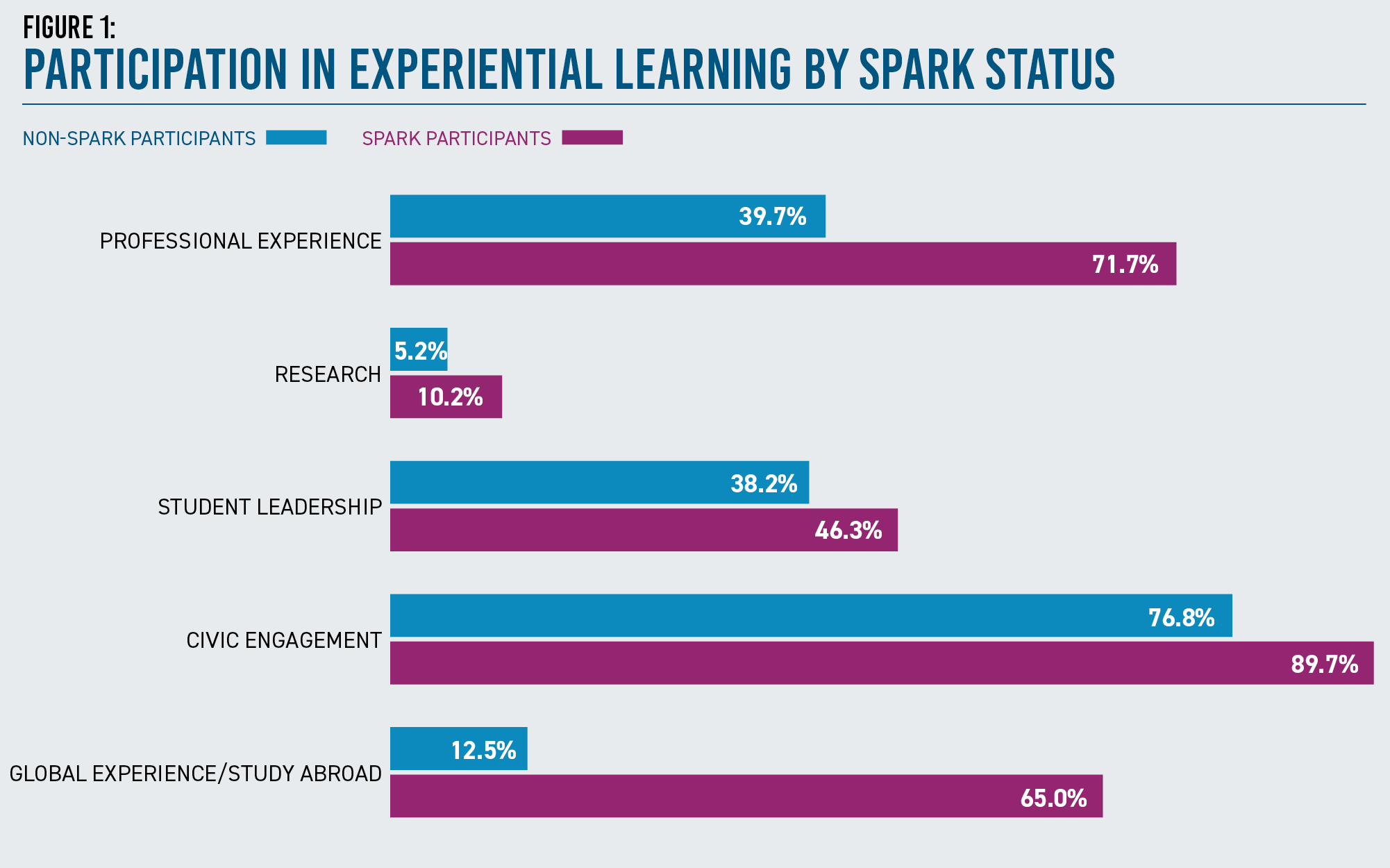
As the dust settles on the first few years of the grant, and as we emerge from the COVID-19 pandemic, the grant’s impact has been encouraging and rewarding. Analysis of SPARK grant participant data by cohorts confirms research found by several other scholars. The high-impact practices of internships, study abroad, and research correlate with several positive student success metrics—higher GPA as well as increased retention and graduation rates. Additionally, while all students benefited, historically marginalized populations experienced even greater gains. It was particularly encouraging to see that an intentional approach to build awareness and support means Nazareth is, indeed, flipping the narrative and building a program where students who stand to gain the most are no longer the students who participate the least. A strong partnership between the Center for Life’s Work and the division of Culture, Community, and Belonging has allowed for collaboration on shared equity in access goals that are expected to grow in future years.
As Figure 1 suggests, SPARK appears to act as a gateway experience, generating greater engagement throughout the remainder of college, producing a more likely scenario that students will experience the benefits of multiple HIPs. The learner-centered nature of the grant’s three options allows students the flexibility of choice while the built-in financial relief and the coaching support to navigate and secure an experience remove barriers that often result in early engagement being limited by a student’s personal social capital.
Pandemic Problems
Although participation in the first few years of the grant has been very promising, it is evident that the pandemic took a toll on experiential learning. In the summer of 2020, opportunities were extremely limited. Students whose SPARK eligibility was set to expire in August of 2020 were given an extra year to use the grant, but timing and continued pandemic restrictions made it difficult for some students to complete an additional experience together with upper-level requirements. Remote internships and research took place and have continued in some spaces, but study abroad was non-existent and continued to be unavailable until spring 2022. If the early trajectory had continued, study abroad may have outpaced internships in terms of student participation. Nazareth’s Center for International Education is now experiencing a flurry of activity and pent-up demand in study abroad and is working hard to accommodate all student interest.
Next Steps and Future Considerations
While early success measures of SPARK participation include increased retention, engagement, and GPAs, Nazareth is eager to continue following the SPARK students through their post-graduate lives. Will they report greater satisfaction with their college degree? Be more likely to engage as alumni? Will they experience greater career mobility? Longitudinal studies that capture quantitative measures as well as qualitative themes have the ability to influence future initiatives and resource allocation.
Initial funding for the SPARK grant has been provided through a combination of fundraising efforts and institutional strategic dollars. Work continues to build an endowment ensuring the initiative’s longevity. Additionally, $1,500 is enough to make many experiences possible, but it doesn’t make every experience possible. The increasing cost of international flights, transportation to and from internship and research sites, geographic barriers that require paying for summer housing, inflation—these are all ongoing challenges that create a moving target and a continual need to monitor and implement truly equitable practices.
Our Role in Redesigning Higher Ed
As faculty and staff, we often toil away in our daily responsibilities without pausing to consider the larger system of higher education to which we belong. However, if we are in the trenches and on the front lines, it is imperative that we share what we see, convey what we know to be true, and play a role in redesigning the system of higher education.
If we know that participation in a variety of experiential learning makes a difference in the lives of our students, we have a moral obligation to continue crafting better systems that lift everyone. Conversely, if higher education institutions do not build a scaffolded and supportive structure for experiential learning, then student participation in multiple HIPs, such as internships, study abroad, and mentored research, will continue to be limited to the lucky and the privileged. Moving the needle to increase participation in early experiential learning that better serves all students requires us to think differently about our processes and structures. It requires collaboration across divisions, finding kindred spirits in like-minded offices, and reimagining career centers as connecting hubs of experiential learning. If we take on this work, we embrace an exciting, rewarding, and difficult challenge. When institutions say that they value—or even require—experiential learning, are they doing it in a way that still centers the learner while also sharing in the responsibility to make it possible for all their students? Can we commit to continually examining how we actually fulfill the promises we make to our learners about the value of college?
Those of us in career centers are uniquely situated to bring our campuses together and lead a redesign. We know what goes into the secret sauce of a transformative education because we see it firsthand. Our roles are all about navigating transitions and getting students from here to there. We can’t keep quiet about what we’re witnessing and what works. Our students need a better system, and we are poised to be courageous changemakers and designers of this new system.
Endnotes
1 Zilvinskis, J., Kinzie, J., Daday, J., O’Donnell, K., & Zande, C.V. (Eds.). (2022). Delivering on the promise of high-impact practices: Research and models for achieving equity, fidelity, impact, and scale. Stylus Publishing, LLC.
2 Kuh, G. D., & O'Donnell, K. (2013). Ensuring quality and taking high-impact practices to scale. Peer Review, 15(2), 32. Retrieved from https://link.gale.com/apps/doc/A339018909/AONE?u=nysl_oweb&sid=googleScholar&xid=a4ca0e31.
3 Chittum, J. R., Enke, K. A. E., & Finley, A. P. (2022). The effects of community-based and civic engagement in higher education. American Association of Colleges & Universities. Retrieved from www.aacu.org/research/the-effects-of-community-based-engagement-in-higher-education; Finley, A., & McNair, T. (2013). Assessing underserved students’ engagement in high-impact practices. Association of American Colleges & Universities. Retrieved from http://files.eric.ed.gov/fulltext/ED582014.pdf; Kuh, et al. (2013); Kuh, G. D. (2008). High-impact educational practices. Association of American Colleges and Universities. Retrieved from www.aacu.org/publication/high-impact-educational-practices-what-they-are-who-has-access-to-them-and-why-they-matter.
4 Di Maggio, L. M. (2019). An analysis of the connections between involvement in study abroad, other high impact educational practices, and co-curricular activities. Frontiers: The Interdisciplinary Journal of Study Abroad, 31(1), 111–130; Kuh, et al. (2013); Reilly, S., & Langley-Turnbaugh, S. (2021). Synergistic effects between undergraduate research and other high-impact practices. Journal of Student Success and Retention 7(1).
5 Twang, A. H. (2022). High-impact learning experiences and post-graduate outcomes: Exploring the influence on employment, continuing education and salary. The SUNY Journal of the Scholarship of Engagement: JoSE, 2(1). Retrieved from https://digitalcommons.cortland.edu/jose/vol2/iss1/2/.
6 Conefrey, T. (2021). Supporting first-generation students’ adjustment to college with high-impact practices. Journal of College Student Retention: Research, Theory & Practice, 23(1), 139–160. Retrieved from https://doi.org/10.1177/1521025118807402; Provencher, A., & Kassel, R. (2019). High-impact practices and sophomore retention: Examining the effects of selection bias. Journal of College Student Retention: Research, Theory & Practice, 21(2), 221-241.
7 Swenson, R., Greiman, B. C., & Nelson, R. (2018). Engaging students with experiential learning. NACTA Journal, 62(3), 260-266.
8 Leigh, E. (2021, December 8). Understanding undergraduates’ career preparation experiences. Strada Education. Retrieved from https://cci.stradaeducation.org/pv-release-dec-8-2021/.
9 Greenman, S. J., Chepp, V., & Burton, S. (2022). High-impact educational practices: leveling the playing field or perpetuating inequity?. Teaching in Higher Education, 27(2), 267-279; Hora, M. T., Wolfgram, M., & Chen, Z. (2019). Closing the doors of opportunity: How financial, sociocultural and institutional barriers intersect to inhibit participation in college internships (WCER Working Paper No. 2019-8). Retrieved from www.wcer.wisc.edu/publications/working-papers; Valentine, J., Price, D., & Yang, H. (2021). High-impact practices and gains in student learning: Evidence from Georgia, Montana, and Wisconsin. Lumina Foundation. Retrieved from www.luminafoundation.org/resource/high-impact-practices-and-gains-in-student-learning.
10 Trogden, B. G., Kennedy, C., & Biyani, N. K. (2022). Mapping and making meaning from undergraduate student Engagement in high-impact educational practices. Innovative Higher Education. Retrieved from https://doi-org.ezproxy.neu.edu/10.1007/s10755-022-09608-7; Ro, H. K., Lee, J., Fernandez, F., & Conrad, B. H. (2021). We don’t know what they did last summer: Examining relationships among parental education, faculty interaction, and college students’ post-first year summer experiences. Innovative Higher Education, 46(1), 21-39.
11 Gonzales, S. M., Baier, S. T., & Brammer, E. C. (2022). Are you HIP?: How one Latinx learning community integrates ten high-impact practices to foster student success. A practice report. Student Success, 13(1), 74–79. Retrieved from https://doi-org.ezproxy.neu.edu/10.5204/ssj.1907; Parks-Yancy, R. (2012). Interactions into opportunities: Career management for low-income, first-generation African American college students. Journal of College Student Development, 53(4), 510-523 Retrieved from https://doi.org/10.1353/csd.2012.0052; Zilvinskis, J. (2019). Measuring quality in high-impact practices. Higher Education, 78(4), 687-709.
12 Coker, J. S., & Porter, D. J. (2016). Student motivations and perception across and within five forms of experiential learning. The Journal of General Education 65(2), 138-156. Retrieved from www.muse.jhu.edu/article/649691; Wolniak, G.C., & Engberg, M.E. (2019). Do "high-impact" college experiences affect early career outcomes? The Review of Higher Education, 42(3), 825-858. doi:10.1353/rhe.2019.0021.
13 Kolb, A. Y., Kolb, D. A., Passarelli, A., & Sharma, G. (2014). On becoming an experiential educator: The educator role profile. Simulation & Gaming, 45(2), 204–234. Retrieved from https://doi.org/10.1177/1046878114534383.
14 Greenman, et al. (2022); Hora, M. T., Chen, Z., Parrott, E., & Her, P. (2020). Problematizing college internships: Exploring issues with access, program design, and developmental outcomes. International Journal of Work-Integrated Learning, 21(3), 235-250; Valentine, et al (2021).





